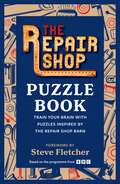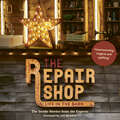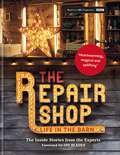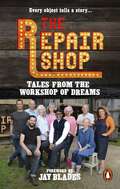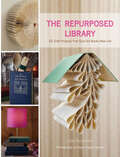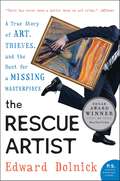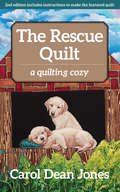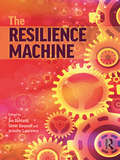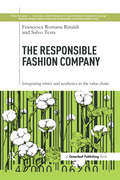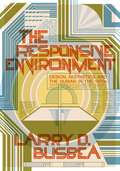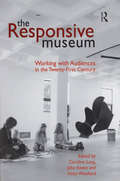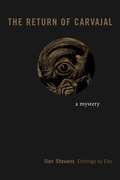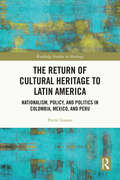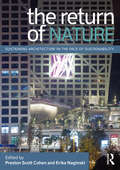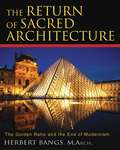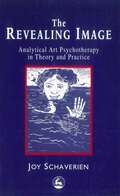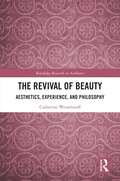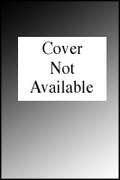- Table View
- List View
The Repair Shop Puzzle Book: Train your brain with puzzles inspired by the Repair Shop barn
by The Repair ShopThe first puzzle book based on the BAFTA-award-winning television show The Repair Shop, with a foreword from The Repair Shop clocks expert Steve Fletcher.Think you know about the Repair Shop, its crafts, craftspeople and stories? Looking for fun brainteasers, word games and quizzes to train your brain and hone your problem solving skills? It's time to put your knowledge to the test with this collection of questions and puzzles designed to challenge and entertain.Blending together basic trivia, complex wordplay and a range of visual teasers, the book calls on the knowledge of Repair Shop fans to provide hours of challenges inspired by the iconic barn and the work that goes on inside. From silversmithing and woodworking, to teddy bears, clocks and paintings, the puzzles draw on the wide range of skills and objects that the Repair Shop team are famed for.With difficulty levels varying from pleasantly tricky to fiendishly hard, The Repair Shop Puzzle Book will delight all fans of the show.
The Repair Shop Puzzle Book: Train your brain with puzzles inspired by the Repair Shop barn
by The Repair ShopThe first puzzle book based on the BAFTA-award-winning television show The Repair Shop, with a foreword from The Repair Shop clocks expert Steve Fletcher.Think you know about the Repair Shop, its crafts, craftspeople and stories? Looking for fun brainteasers, word games and quizzes to train your brain and hone your problem solving skills? It's time to put your knowledge to the test with this collection of questions and puzzles designed to challenge and entertain.Blending together basic trivia, complex wordplay and a range of visual teasers, the book calls on the knowledge of Repair Shop fans to provide hours of challenges inspired by the iconic barn and the work that goes on inside. From silversmithing and woodworking, to teddy bears, clocks and paintings, the puzzles draw on the wide range of skills and objects that the Repair Shop team are famed for.With difficulty levels varying from pleasantly tricky to fiendishly hard, The Repair Shop Puzzle Book will delight all fans of the show.
The Repair Shop: LIFE IN THE BARN: The Inside Stories from the Experts: THE BRAND NEW BOOK FOR 2022
by Elizabeth Wilhide Jayne Dowle'Heartwarming, magical and uplifting'In today's throwaway culture, there's a counter movement growing that urges us to 'make do and mend'. The Repair Shop has brought this waste-conscious message to an even wider audience, with its regular viewing figures of 7 million in the UK alone, cementing itself as a classic series in the vein of Antiques Roadshow.This new book concentrates on the show's much-loved experts, including woodworker and furniture restorer Will Kirk, clock restorer Steve Fletcher, metalworker Dominic Chinea, silversmith Brenton West, leatherworker Suzie Fletcher, upholsterer Sonnaz Nooranvary, and seamstresses Julie Tatchell & Amanda Middleditch - aka The Teddy Bear Ladies. Each of the experts shares their own stories and their repairs, capturing in the process the magic and ethos of the barn. Includes quotations and Q & As from the experts as well as Jay Blades on some unique restoration collaborations.With the focus on the experts themselves, readers will feel as though they're stepping straight into the 'workshop of dreams' and experiencing first hand the magic of the barn.2022 Octopus Publishing Group
The Repair Shop: LIFE IN THE BARN: The Inside Stories from the Experts: THE LATEST BOOK
by Elizabeth Wilhide Jayne Dowle'Heartwarming, magical and uplifting'In today's throwaway culture, there's a counter movement growing that urges us to 'make do and mend'. The BBC's BAFTA Award winning The Repair Shop has brought this waste-conscious message to an even wider audience, with its regular viewing figures of 7 million in the UK alone, cementing itself as a classic series in the vein of Antiques Roadshow.This new book concentrates on the show's much-loved experts, including woodworker and furniture restorer Will Kirk, clock restorer Steve Fletcher, metalworker Dominic Chinea, silversmith Brenton West, leatherworker Suzie Fletcher, upholsterer Sonnaz Nooranvary, and seamstresses Julie Tatchell & Amanda Middleditch - aka The Teddy Bear Ladies. Each of the experts shares their own stories and their repairs, capturing in the process the magic and ethos of the barn. Includes quotations and Q & As from the experts as well as Jay Blades on some unique restoration collaborations.With the focus on the experts themselves, readers will feel as though they're stepping straight into the 'workshop of dreams' and experiencing first hand the magic of the barn.
The Repair Shop: LIFE IN THE BARN: The Inside Stories from the Experts: THE LATEST BOOK
by Elizabeth Wilhide Jayne Dowle'Heartwarming, magical and uplifting'In today's throwaway culture, there's a counter movement growing that urges us to 'make do and mend'. The BBC's BAFTA Award winning The Repair Shop has brought this waste-conscious message to an even wider audience, with its regular viewing figures of 7 million in the UK alone, cementing itself as a classic series in the vein of Antiques Roadshow.This new book concentrates on the show's much-loved experts, including woodworker and furniture restorer Will Kirk, clock restorer Steve Fletcher, metalworker Dominic Chinea, silversmith Brenton West, leatherworker Suzie Fletcher, upholsterer Sonnaz Nooranvary, and seamstresses Julie Tatchell & Amanda Middleditch - aka The Teddy Bear Ladies. Each of the experts shares their own stories and their repairs, capturing in the process the magic and ethos of the barn. Includes quotations and Q & As from the experts as well as Jay Blades on some unique restoration collaborations.With the focus on the experts themselves, readers will feel as though they're stepping straight into the 'workshop of dreams' and experiencing first hand the magic of the barn.
The Repair Shop: Tales from the Workshop of Dreams
by Karen FarringtonWe all have treasures hidden away in the attic, well-loved and well-worn belongings that have been passed down from generation to generation. They may be damaged or no longer working, but we can't bear to part with them. The expert craftspeople of hit BBC series The Repair Shop are dedicated to restoring and conserving these heirlooms. They know that the true worth of these possessions doesn't lie in their monetary value, but in the memories they hold and the stories they tell.In this fascinating book, you'll step inside The Repair Shop's Workshop of Dreams to explore some of the most moving family stories from the hit BBC series. From a glamorous sequinned dress that belonged to a popular travelling circus performer to a pump organ that was brought from Jamaica by a member of the Windrush generation, each family item is brought vividly to life - and lovingly restored by the team of Repair Shop experts who also contribute to these expanded stories. With a foreword by Jay Blades, Tales from the Workshop of Dreams is a heartfelt love letter to our collective past, and a fascinating slice of social history.This book features items fixed by Repair Shop experts Steve Fletcher, Will Kirk, Lucia Scalisi, Suzie Fletcher, Kirsten Ramsay, Dominic Chinea, Brenton West, Tim Gunn, Sara Dennis, Chris Shaw, Matt Nickels, Amanda Middleditch and Julie Tatchell. With great care and attention to detail, the Repair Shop team resurrect priceless pieces of family history and breathe new life into the stories they hold.
The Repurposed Library: 33 Craft Projects That Give Old Books New Life
by Lisa Occhipinti“How-to instructions on crafting with books . . . will inspire you to think about creative ways to make new treasures out of old things” (The Virginian-Pilot).We all love to read and learn from books, but The Repurposed Library takes our passion even further, presenting us with thirty-three projects to make—quite literally—out of books. For these projects, Lisa Occhipinti rescues and repurposes orphaned and outdated books from flea markets and library sales and turns them into new art objects and practical items for the home. Her creations range from artfully constructed mobiles, wreaths, and vases, to functional items like shelves, storage boxes, and even a Kindle “keeper” for those who want to replicate the sensation of holding a “real” book while reading from an e-reader. Projects utilize every imaginable part of a book—from hardback cover to individual pages—and are a DIY celebration of a new way to view a book’s potential.“Occhipinti’s ‘repurposed’ books are truly beautiful art objects, and whether or not you’re crafty enough to give them a try yourself, her book is thoroughly enjoyable.” —Fine Books and Collections“She shows readers how to transform books into mobiles, lamp shades, even clocks.” —National Post
The Rescue Artist: A True Story of Art, Thieves, and the Hunt for a Missing Masterpiece
by Edward DolnickIn the predawn hours of a gloomy February day in 1994, two thieves entered the National Gallery in Oslo and made off with one of the world's most famous paintings, Edvard Munch's Scream. It was a brazen crime committed while the whole world was watching the opening ceremonies of the Winter Olympics in Lillehammer. Baffled and humiliated, the Norwegian police turned to the one man they believed could help: a half English, half American undercover cop named Charley Hill, the world's greatest art detective.The Rescue Artist is a rollicking narrative that carries readers deep inside the art underworld -- and introduces them to a large and colorful cast of titled aristocrats, intrepid investigators, and thick-necked thugs. But most compelling of all is Charley Hill himself, a complicated mix of brilliance, foolhardiness, and charm whose hunt for a purloined treasure would either cap an illustrious career or be the fiasco that would haunt him forever.
The Rescue Quilt: A Quilting Cozy (A\quilting Cozy Ser. #7)
by Carol Dean JonesA tale of mystery, family, and furry friends in a busy retirement community—includes instructions for the featured quilt! Sarah Miller, dedicated quilter and resident of the Cunningham Village retirement community, may be a senior but she&’s still full of energy—which she puts into her beloved crafts and, sometimes, into solving crimes. Now she&’s about to embark on some amateur detection as her dear friend Sophie encounters several major life changes—including two new family members and a job working with abandoned animals…
The Resilience Machine
by Simin Davoudi Jennifer L. Lawrence Jim BohlandWe live in a time where environmental pressures, social inequities and political derision are the backdrop of everyday life, and where resilience has become a routine prescription for coping with the conditions of modern existence. Drawing an analogy to Harvey Molotch’s urban growth machine, this book explores different narratives of resilience and their policy and practice manifestations for cities, citizens and communities. It expands on the metaphor of the machine to show how resilience can be better understood as an assemblage. Bringing together authors from multiple disciplines and different parts of the world, the book unmasks the often invisible effects of resilience strategies by examining ways in which neoliberal mentalities are fed through the rhetoric of resilience practices, policies and development projects. The contributing essays provide provocative accounts of several areas of inquiry, including biopolitics and smart bodies, resilient cities and communities, urban planning and disaster management, justice and vulnerability, and resistance to resilience. Holding out hope for critical potentials in ‘resilience,’ The Resilience Machine proposes to move beyond mechanisms of adaptation and into imagining what resilient life could look like in a more just, equitable and democratic world. The Resilience Machine is a current, vital addition to resilience, community and urban scholarship.
The Responsible Fashion Company: Integrating Ethics and Aesthetics in the Value Chain
by Francesca Romana Rinaldi Salvo TestaIn The Responsible Fashion Company, Rinaldi and Testa argue that the fashion industry is at a crossroads: the need for a global shift to a sustainable model has never been more urgent. Yet, they demonstrate that we are witnessing a revolution led by conscious consumers and enlightened companies, who are redefining the rules of the fashion market. The question is: when will the rest of the industry catch up? Rinaldi and Testa raise a fundamental but often neglected issue in the fashion sustainability debate: long-term equilibrium can only be achieved by integrating economic goals with environmental, social and ethical values. "The Responsible Fashion Company" provides a clear overview of the theory, challenges and opportunities of sustainability in the industry and demonstrates how fashion companies can achieve competitive advantage through sustainable innovation. The authors show how leading fashion companies are challenging traditional thinking and present inspiring examples from pioneers such as Gucci, Levi's, Timberland and Brunello Cucinelli, who create quality products without leaving a negative impact behind.Refreshing and timely, The Responsible Fashion Company is essential reading for the socially conscious consumer and anyone with a professional or personal interest in the fashion, design and luxury industries.
The Responsive Environment: Design, Aesthetics, and the Human in the 1970s
by Larry D. BusbeaHow new conceptions of human–environment interaction became central to design theories and practices in the 1970s At the end of the 1960s, new models of responsiveness between humans and their environments had a profound impact on theories and practices in architecture, design, art, technology, media, and the sciences. The resulting initiatives—design philosophies, art installations, architectural projects, exhibitions, publications, and symposia—sought to bring together insights from biology, systems theory, psychology, and anthropology with modernist legacies of total design.In The Responsive Environment, Larry D. Busbea takes up this concept of environment as an object and method of design at the height of its aesthetic, technical, and discursive elaboration. Exploring emerging paradigms of environmental perception, patterning, and control as developed by Gregory Bateson, Edward T. Hall, Wolf Hilbertz, György Kepes, Marshall McLuhan, Nicholas Negroponte, Paolo Soleri, and others, he shows how living space itself was reimagined as a domain capable of modification through input from its newly sensitized inhabitants.The Responsive Environment intercuts the development of new ideas about environmental awareness with case studies of specific architecture and design projects for responsive environments. Throughout, Busbea connects these theories and practices to the contemporary obsession with &“smart&” things: responsive technologies, intelligent environments, biomimetic materials, and digital atmospherics.
The Responsive Museum: Working with Audiences in the Twenty-First Century
by Caroline Lang John ReeveWhat is the relationship today between museums, galleries and learning? The Responsive Museum interrogates the thinking, policies and practices that underpin the educational role of the museum. It unravels the complex relationship of museums with their publics, and discusses today's challenges and the debates that have resulted. The highly experienced team of writers, including museum educators and directors, share their different experiences and views, and review recent research and examples of best practice. They analyse the implications of audience development and broadening public access, particularly in relation to special groups, minority communities and disabled people, and for individual self-development and different learning styles; they explore issues of public accountability and funding; discuss the merits of different evaluation tools and methodologies for measuring audience impact and needs; and assess the role of architects, designers and artists in shaping the visitor experience. The latter part of this book reviews practical management and staffing issues, and training and skills needs for the future. This book is for students, museum staff, especially those involved in education and interpretation, and senior management and policy-makers. This is a much-needed review of the relationship between museums and galleries and their users. It also offers a wealth of information and expertise to guide future strategy and practice.
The Retronaut Guide to Raising Children: The Past Like You Wouldn't Believe
by Wolfgang WildThe highly successful Retronaut blog looks at the past as it has never been looked at before. Here, in the second of a new series of Retronaut books, the site's founder, Wolfgang Wild, brings you a thought-provoking collection of photographs from our hidden history. Often witty and entertaining, but also thought-provoking and at times puzzling, the images are chosen to shift our perceptions, making us think-and look again. Discover what our ancestors considered to be good parenting in the days before the 'care' was put into childcare, from dangerous sports to the best brand of cigarette for your baby. A perfectly reassuring gift for today's new parent, this book will also appeal to anyone who likes pictures of babies in sunglasses.
The Return of Carvajal: A Mystery
by Ilan StavansIn 2017, the New York Times announced that the long-lost memoir of Luis de Carvajal the Younger had been rediscovered. Considered the first autobiography by a Jew in the Americas, the book had been stolen decades earlier from Mexico’s National Archives. Here, Ilan Stavans recounts the extraordinary and entertaining story of the reappearance of this precious object and how its discovery opened up new vistas onto the world of secret Jews escaping the Spanish Inquisition.Called el Mozo (the Younger) to distinguish him from an uncle of the same name who was governor of Nuevo León, Luis de Carvajal learned of his Jewishness after being raised a Catholic. He came to recognize himself as a messiah for fellow crypto-Jews, and he was burned at the stake on December 8, 1596, in the biggest auto-da-fé in all of Latin America. His memoir—a 180-page manuscript written by a crypto-Jew targeted by the Holy Office of the Inquisition for unlawful proselytizing activities—was not only distinct but of enormous value.With characters such as conniving academics embroiled in a scholarly feud, a magnanimous philanthropist, naïve booksellers, and a secondary cast that could be taken from a David Lynch film, The Return of Carvajal recounts the global intrigue that placed crypto-Jewish culture at the heart of contemporary debates on religion and identity.
The Return of Carvajal: A Mystery
by Ilan StavansIn 2017, the New York Times announced that the long-lost memoir of Luis de Carvajal the Younger had been rediscovered. Considered the first autobiography by a Jew in the Americas, the book had been stolen decades earlier from Mexico’s National Archives. Here, Ilan Stavans recounts the extraordinary and entertaining story of the reappearance of this precious object and how its discovery opened up new vistas onto the world of secret Jews escaping the Spanish Inquisition.Called el Mozo (the Younger) to distinguish him from an uncle of the same name who was governor of Nuevo León, Luis de Carvajal learned of his Jewishness after being raised a Catholic. He came to recognize himself as a messiah for fellow crypto-Jews, and he was burned at the stake on December 8, 1596, in the biggest auto-da-fé in all of Latin America. His memoir—a 180-page manuscript written by a crypto-Jew targeted by the Holy Office of the Inquisition for unlawful proselytizing activities—was not only distinct but of enormous value.With characters such as conniving academics embroiled in a scholarly feud, a magnanimous philanthropist, naïve booksellers, and a secondary cast that could be taken from a David Lynch film, The Return of Carvajal recounts the global intrigue that placed crypto-Jewish culture at the heart of contemporary debates on religion and identity.
The Return of Cultural Heritage to Latin America: Nationalism, Policy, and Politics in Colombia, Mexico, and Peru
by Pierre LossonThe Return of Cultural Heritage to Latin America takes a new approach to the question of returns and restitutions. It is the first publication to look at the domestic politics of claiming countries in order to understand who supports the claims and why. Drawing on analysis of articles published in national newspapers and interviews with individuals involved in return claims, the book demonstrates that such claims are inherently political. Focusing on Colombia, Mexico, and Peru, the book analyses how return claims contribute to the strengthening of state-sponsored discourses on the nation; the policy formation process that leads to the formulation of return claims; and who the main actors of the claims are, including civil society individuals, experts, state authorities, and Indigenous communities. The book proposes explanations for why Latin American countries are interested in specific objects held in Western museums and why these claims have come to light over the past three decades. The Return of Cultural Heritage to Latin America argues that return claims ought to be the object of public debate, allowing contemporary societies to address the legacy of colonialism. The book will be essential reading for scholars and students engaged in the study of museums and heritage, political science, history, anthropology, cultural policy and Latin America.
The Return of Nature: Sustaining Architecture in the Face of Sustainability
by Preston Scott Cohen Erika NaginskiThe Return of Nature asks you to critique your conception of nature and your approach to architectural sustainability and green design. What do the terms mean? Are they de facto design requirements? Or are they unintended design replacements? The book is divided into five parts giving you multiple viewpoints on the role of the relations between architecture, nature, technology, and culture. A detailed case study of a built project concludes each part to help you translate theory into practice. This holistic approach will allow you to formulate your own theory and to adjust your practice based on your findings. Will you provoke change, design architecture that responds to change, or both? Coedited by an architect and a historian, the book features new essays by Robert Levit, Catherine Ingraham, Sylvia Lavin, Barry Bergdoll, K. Michael Hays, Diane Lewis, Andrew Payne, Mark Jarzombek, Jean-Francois Chevrier, Elizabeth Diller, Antoine Picon, and Jorge Silvetti. Five case studies document the work of MOS Architects, Michael Bell Architecture, Steven Holl Architects, George L. Legendre, and Preston Scott Cohen.
The Return of Sacred Architecture: The Golden Ratio and the End of Modernism
by Herbert BangsAn inspirational call for a return to the tenets of traditional architecture as a remedy for the dehumanizing standards of modern architecture • Explains how modern architecture is emblematic of our current estrangement from the spiritual principles that shaped humanity’s greatest civilizations • Reveals how the ancient laws of sacred proportion and harmony can be restored The ugly buildings that characterize the modern landscape are inferior not only to the great cathedrals of medieval Europe and the temples of ancient Egypt and Greece, but even to lesser buildings of the more recent past. The great masterworks of our ancestors spoke to humanity’s higher nature. Architect Herbert Bangs reveals how today’s dysfunctional buildings bring out the worst in humanity, reinforcing that which is most base within us. He shows how, through the ancient laws of proportion and number, architecture once expressed the harmonious relationship between man and the cosmos. In early times, the architect worked within a sacred and esoteric tradition of creating structures through which human beings could gain insight into the nature of the divine reality. Today, that tradition has been abandoned in favor of narrowly defined utilitarian principles of efficiency and economy. In The Return of Sacred Architecture, Bangs provides the key to freeing architecture from the crude functionality of the twentieth century: the architects of the modern human landscape must find the deep-felt connection to the cosmos that guided the inner lives of those who built the temples of the past. The form of their buildings will then reflect the sacred patterns of geometry and proportion and bring forth greater harmony in the world.
The Revealing Image: Analytical Art Psychotherapy in Theory and Practice
by Joy SchaverienSchaverien painstakingly describes and defines "processes which have so far only been intuitively known to art therapists" (p6) by introducing and elaborating the psychoanalytical concepts of transference and countertransference in relation to the use of visual art objects. The authors stated intention in this book is "to attempt to bridge the perceived gap between the practice of art therapy and analytical forms of psychotherapy..."(p 229) The epistemological base of this venture includes the fields of philosophy, anthropology, and aesthetics, as well as psychoanalysis.Schaverien suggests that analytical art psychotherapy is a way of working analytically with patients who are unsuitable, or unready, for psychotherapy, giving examples of psychotic and borderline patients, children, and patients in psychiatric settings.This is primarily a book about an analytical approach within art therapy, which may be of interest in itself. The material also raises issues of interest to analysts and psychotherapists, whether or not they work with art in the clinical setting. The book clarifies areas of similarity between the disciplines, and also makes areas of difference apparent. For example, most analysts would agree that visual art, like dream material, and other non-verbal representations of the inner world, can at times articulate and communicate meanings which for one reason or another cannot be verbally articulated at the time, and that this can be pertinent to the aim of analysis. However, I think few analysts would include facilities in their consulting rooms for the kind of art processes described in the book.When the analyst is working with materials in this form, the book will be extremely helpful in sorting out the complexity of the transference situation and the role of interpretation. The book is so strongly grounded in experiences emerging in the presence of actual art processes and objects that I think it will be of most interest to those who are interested in the specific clinical issues involved in relating to the making and use of actual art objects within the setting. Schaverien not only describes the processes involved in detail, but also presents technical approaches to the making and handling of art objects within the setting which will inform the capacity of those who are not trained as art therapists to relate to this kind of material in the consulting room.'
The Reverend Billy Project: From Rehearsal Hall to Super Mall with the Church of Life After Shopping
by Bill Talen Savitri DReverend Billy, the revivalist preacher created by performance artist Bill Talen, has attracted an international following as he has railed in white suit and clerical collar against the evils of excessive consumerism and corporate irresponsibility. In his early solo performances in Times Square he delivered sermons by megaphone against Starbucks and the Disney Store; as his message and popularity spread, he's been joined by a 35-member choir (the Life After Shopping Gospel Choir) and a 7-piece band. The group's acclaimed stage show and media appearances (including a major motion picture,What Would Jesus Buy?) have reached millions. The Reverend Billy Project presents backstage accounts of recent performance actions by Reverend Billy and the troupe's director, Savitri D, recounting their exploits on three continents in vivid narratives that are engaging, shrewdly analytical, and at times side-splittingly funny. We watch as the group plans invisible theater interventions in Starbucks, designs a mermaid hunger strike to thwart gentrification plans for Coney Island, and makes an extended effort to preserve the public nature of New York's Union Square. We follow them to an action camp in Iceland and a flop of a show redeemed by a successful impromptu demonstration in a Berlin shopping mall. As thoughtful as they are funny and inventive, Reverend Billy and Savitri D's story-essays bring to life a playful yet sincere new form of political theater. "The Reverend Billy Project lucidly and perceptively explains the Reverend Billy phenomenon with wry, infectious humor and remarkable intelligence. Though many political activists have used theater and performance to achieve political ends, very few have left such articulate reports on what they did, let alone detailed road maps of the treacherous theatrical, political, and psychological territory they negotiated." ---Jonathan Kalb, Hunter College.
The Revival of Beauty: Aesthetics, Experience, and Philosophy (Routledge Research in Aesthetics)
by Catherine WesselinoffThis book provides original descriptive accounts of two schools of thought in the philosophy of beauty: the 20th-century “Anti-Aesthetic” movement and the 21st-century “Beauty Revival” movement. It also includes a positive defence of beauty as a lived experience extrapolated from Beauty-Revival position. Beauty was traditionally understood in the broadest sense as a notion that engages our sense perception and embraces everything evoked by that perception, including mental products and affective states. This book constructs and places in parallel with one another the Anti-Aesthetic and Beauty-Revival movements. In the author’s view, Anti-Aestheticism is devoted to a decisive negation of beauty—denying its importance as a philosophical notion and its significance as a lived experience. It suggests that beauty is a merely sensual experience, which can be used, at best, as a distraction from justice and, at worst, as an instrument of evil. Alternatively, the Beauty-Revival movement advances arguments for beauty as an experience that extends primarily to sensual experience, but which also calls forth mental products and cognitive and affective states evoked by that experience. After reconstructing these two positions, the author elaborates on the notion of beauty as a lived experience through three key moments which occur in the process of our experiencing beautiful objects. These moments are (a) the conditions that constitute an experience of beauty, (b) the attitudinal features most likely to lead to the experience of beauty, and (c) the results of the experience of beauty. The Revival of Beauty will be of interest to scholars and advanced students working in aesthetics, history of philosophy, and art history.
The Revival of Beauty: Aesthetics, Experience, and Philosophy (Routledge Research in Aesthetics)
by Catherine WesselinoffThis book provides original descriptive accounts of two schools of thought in the philosophy of beauty: the 20th-century “Anti-Aesthetic” movement and the 21st-century “Beauty Revival” movement. It also includes a positive defence of beauty as a lived experience extrapolated from Beauty-Revival position.Beauty was traditionally understood in the broadest sense as a notion that engages our sense perception and embraces everything evoked by that perception, including mental products and affective states. This book constructs and places in parallel with one another the Anti-Aesthetic and Beauty-Revival movements. In the author’s view, Anti-Aestheticism is devoted to a decisive negation of beauty—denying its importance as a philosophical notion and its significance as a lived experience. It suggests that beauty is a merely sensual experience, which can be used, at best, as a distraction from justice and, at worst, as an instrument of evil. Alternatively, the Beauty-Revival movement advances arguments for beauty as an experience that extends primarily to sensual experience, but which also calls forth mental products and cognitive and affective states evoked by that experience. After reconstructing these two positions, the author elaborates on the notion of beauty as a lived experience through three key moments which occur in the process of our experiencing beautiful objects. These moments are (a) the conditions that constitute an experience of beauty, (b) the attitudinal features most likely to lead to the experience of beauty, and (c) the results of the experience of beauty.The Revival of Beauty will be of interest to scholars and advanced students working in aesthetics, history of philosophy, and art history.
The Revolution Takes Form: Art and the Barricade in Nineteenth-Century France
by Jordan Marc RoseDuring the French Revolution of 1830, insurgents raised some four thousand barricades. Afterward, lithographs of the street fighting flowed from the presses, creating the barricade’s first imagery. This book documents the changing political valence of the revolutionary ideals associated with the barricade in France from 1830 to 1852.The Revolution Takes Form coordinates the political reality of the barricade with the divergent ways in which its image gave shape to the period’s conceptions of class, revolution, and urban space. Engaging the instability of the barricade, art historian Jordan Marc Rose focuses on five politically charged works of art: Eugène Delacroix’s La Liberté guidant le peuple, Honoré Daumier’s Rue Transnonain, le 15 avril 1834 and L’Émeute, Auguste Préault’s Tuerie, and Ernest Meissonier’s Souvenir de guerre civile. The history of these artworks illuminates how such revolutionary insurrections were characterized—along with the conceptions of “the people” they mobilized. Foregrounding a trajectory of disillusionment, growing class tensions, and ultimately open conflict between bourgeois liberals and the proletariat, Rose both explains why the barricade became a compelling subject for pictorial reflection and accounts for its emergence as the period’s most poignant and meaningful symbol of revolution.Original and convincing, this book will appeal to students and scholars of art history and, in particular, of the history of the French Revolution.
The Revolution Was Televised: The Cops, Crooks, Slingers, and Slayers Who Change
by Alan SepinwallA phenomenal account, newly updated, of how twelve innovative television dramas transformed the medium and the culture at large, featuring Sepinwall's take on the finales of Mad Men and Breaking Bad.In The Revolution Was Televised, celebrated TV critic Alan Sepinwall chronicles the remarkable transformation of the small screen over the past fifteen years. Focusing on twelve innovative television dramas that changed the medium and the culture at large forever, including The Sopranos, Oz, The Wire, Deadwood, The Shield, Lost, Buffy the Vampire Slayer, 24, Battlestar Galactica, Friday Night Lights, Mad Men, and Breaking Bad, Sepinwall weaves his trademark incisive criticism with highly entertaining reporting about the real-life characters and conflicts behind the scenes. Drawing on interviews with writers David Chase, David Simon, David Milch, Joel Surnow and Howard Gordon, Damon Lindelof and Carlton Cuse, and Vince Gilligan, among others, along with the network executives responsible for green-lighting these groundbreaking shows, The Revolution Was Televised is the story of a new golden age in TV, one that's as rich with drama and thrills as the very shows themselves.
